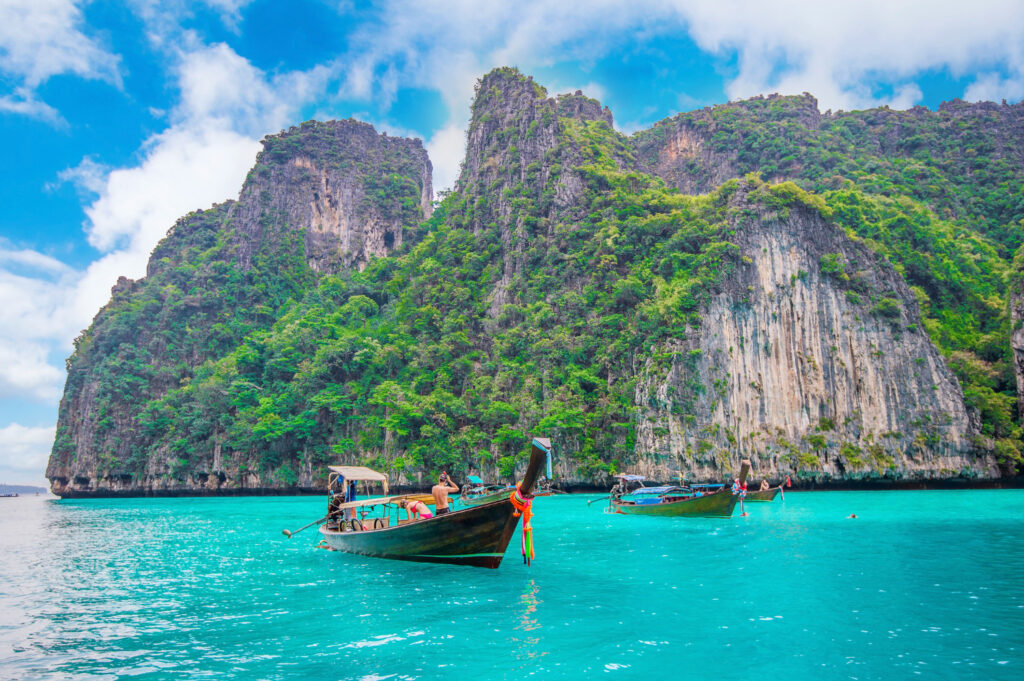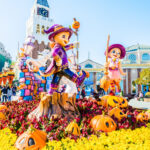As the world eagerly embraces the return of travel post-pandemic, all eyes are on the hottest destinations, capturing the imagination of wanderlust seekers. According to a recent report, a staggering 80% of the trending global travel destinations for 2024 are within Asia’s diverse and enchanting landscapes. In this blog, we unveil the complete list of these coveted Asian destinations and explore the allure that each one holds for adventurous travelers.
Bali, Indonesia:
Topping the list is the picturesque island paradise of Bali, Indonesia. Known for its lush rice terraces, vibrant cultural scene, and idyllic beaches, Bali offers a perfect blend of relaxation and adventure. From exploring ancient temples to diving into crystal-clear waters, visitors are drawn to Bali’s laid-back vibe and breathtaking natural beauty.
Geography and Climate
Bali is an island province of Indonesia located in the westernmost end of the Lesser Sunda Islands, lying between Java to the west and Lombok to the east. It is renowned for its diverse and sophisticated art forms, such as painting, sculpture, woodcarving, handcrafts, and performing arts. Bali’s climate is tropical, warm, and humid year-round, with two main distinctive seasons: a wet season from October to April and a dry season from May to September. The best time to visit is during the dry season when the weather is more pleasant for outdoor activities.
Culture and Traditions
Bali’s culture is a mix of Balinese Hindu-Buddhist religion and Balinese customs. The island is known for its highly developed arts, including traditional and modern dance, sculpture, painting, leather, metalworking, and music. The Balinese culture is full of rituals and ceremonies, particularly evident in its rich temple festivals and the famous cremation ceremonies. Bali’s unique culture, influenced by Balinese Hinduism, distinguishes it from the rest of Indonesia.
Attractions and Activities
- Beaches: Bali is famous for its expansive beaches, such as Kuta, Seminyak, and Nusa Dua, offering everything from serene white-sand coasts to vibrant surf spots.
- Temples: The island is dotted with thousands of temples, each with its unique charm. Notable ones include Tanah Lot, Uluwatu Temple, and Besakih Temple.
- Rice Terraces: The scenic Tegallalang and Jatiluwih rice terraces offer breathtaking views and a glimpse into traditional Balinese agriculture.
- Mount Batur: An active volcano, Mount Batur is a popular spot for sunrise treks, providing stunning views over Lake Batur and the surrounding landscape.
- Ubud: Known as the cultural heart of Bali, Ubud is famous for its art markets, royal palaces, and monkey forest.
- Water Sports and Diving: Bali’s clear waters are perfect for diving, snorkeling, surfing, and other water sports, with spots like Menjangan Island and the wreck of the USAT Liberty.
Cuisine
Balinese cuisine is a feast for the senses, known for its complex flavors and use of a wide array of spices. Must-try dishes include Babi Guling (suckling pig), Bebek Betutu (slow-cooked duck), and Lawar (a traditional mix of vegetables, coconut, and minced meat or fish). Balinese food reflects the island’s culture and offers a variety of dishes for both vegetarians and meat-lovers.
Accommodation
Bali offers a wide range of accommodations to suit every budget and preference, from luxurious beach resorts and private villas to budget hostels and homestays. Areas like Ubud cater to those looking for a serene retreat, while Seminyak and Kuta are more suited for travelers looking for nightlife and entertainment.
Travel Tips
- Respect Local Customs: Be mindful of local traditions and dress codes, especially when visiting temples.
- Transport: Renting a scooter is a popular and convenient way to explore the island, but be sure you’re comfortable with the traffic and have the proper license.
- Health and Safety: Use mosquito repellent to protect against dengue fever, and be cautious with street food to avoid Bali belly.
- Environment: Bali faces challenges with plastic waste; travelers are encouraged to reduce plastic usage and support eco-friendly initiatives.
Bali is not just a destination; it’s an experience that blends breathtaking natural beauty, deep cultural heritage, and the warmth of its people. Whether you’re seeking adventure, relaxation, or cultural immersion, Bali offers an unforgettable escape.
Kyoto, Japan:
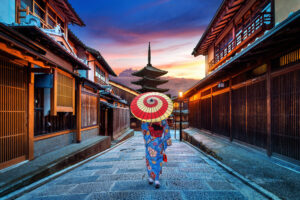 Renowned for its timeless charm and stunning landscapes, Kyoto captures the hearts of travelers with its traditional architecture, serene temples, and vibrant cherry blossoms. As Japan’s cultural and spiritual hub, Kyoto offers a glimpse into the country’s rich heritage. It provides a tranquil retreat from bustling city life found in other Japanese destinations such as Tokyo and Osaka.
Renowned for its timeless charm and stunning landscapes, Kyoto captures the hearts of travelers with its traditional architecture, serene temples, and vibrant cherry blossoms. As Japan’s cultural and spiritual hub, Kyoto offers a glimpse into the country’s rich heritage. It provides a tranquil retreat from bustling city life found in other Japanese destinations such as Tokyo and Osaka.
Kyoto, the heart of traditional Japan, offers a remarkable journey through the country’s rich history, culture, and natural beauty. This ancient city was Japan’s capital for over a millennium and remains a living museum, brimming with temples, shrines, gardens, and centuries-old traditions. Here’s a comprehensive guide to Kyoto, Japan, for travelers seeking an enriching vacation experience.
Geography and Climate
Kyoto is located in the Kansai region of the island of Honshu, Japan. Nestled in a valley, part of the Yamashiro Basin, it is surrounded by mountains on three sides, providing it with a distinct and beautiful natural setting. The city experiences four distinct seasons: a vibrant spring with cherry blossoms, a warm and humid summer, a colorful autumn with changing leaves, and a cold winter that occasionally sees snowfall. Spring (March to May) and autumn (September to November) are considered the best times to visit due to the mild weather and scenic beauty.
Culture and Heritage
Kyoto is the epicenter of traditional Japanese culture, home to over 2,000 religious places, including 1,600 Buddhist temples and 400 Shinto shrines. It is also famous for its traditional tea ceremonies, geisha district (Gion), and numerous festivals throughout the year. Kyoto’s cultural heritage is so significant that the city was spared from the list of atomic bomb targets during World War II.
Major Attractions
- Temples and Shrines: Kinkaku-ji (the Golden Pavilion), Fushimi Inari Taisha with its thousands of vermilion torii gates, and Kiyomizu-dera are must-visit sites.
- Gion: Explore the historic Gion district, known for its traditional wooden machiya houses, teahouses, and a chance to spot a geiko (Kyoto dialect for geisha) or maiko (apprentice geisha).
- Arashiyama: Famous for its bamboo grove, Togetsukyo Bridge, and the Iwatayama Monkey Park.
- Philosopher’s Path: A picturesque walkway that follows a cherry-tree-lined canal in the northern part of the Higashiyama district, especially beautiful in spring.
- Nijo Castle: A UNESCO World Heritage site, known for its beautiful architecture, gardens, and the “nightingale floors” designed to chirp when walked upon, serving as a security measure against intruders.
Cuisine
Kyoto cuisine is known for its refinement and emphasis on seasonal ingredients. Kaiseki, a traditional multi-course meal, showcases the height of Kyoto’s culinary arts. Vegetarian visitors will appreciate shojin ryori, the vegetarian cuisine developed by Buddhist monks. Don’t miss trying Kyoto specialties such as yudofu (simmered tofu), kyo-kaiseki (Kyoto-style kaiseki), and matcha-based sweets.
Accommodations
Kyoto offers a wide range of lodging options, from luxury hotels and traditional ryokan (Japanese inns) to budget guesthouses and hostels. Staying in a ryokan is highly recommended for travelers looking to experience Japanese hospitality and traditional living.
Travel Tips
- Transportation: Kyoto is well-connected by Japan’s efficient public transportation network. The city is served by buses and trains, making it easy to explore. Consider purchasing a Kyoto travel pass for unlimited travel on buses and subways.
- Respect Local Customs: When visiting temples and shrines, observe local customs such as removing shoes where required and being respectful of the serene environment.
- Cash is King: While credit card acceptance is increasing, many smaller establishments, temples, and shrines only accept cash.
- Plan Your Visit: Kyoto is extremely popular during cherry blossom season and autumn foliage season. Accommodations can book up months in advance, so plan accordingly.
Kyoto’s blend of historical significance, cultural depth, and natural beauty makes it a unique destination that offers insights into Japan’s past and present. Whether you’re strolling through ancient streets, marveling at the craftsmanship of centuries-old temples, or indulging in exquisite cuisine, Kyoto promises an unforgettable experience for every traveler.
Siem Reap, Cambodia:
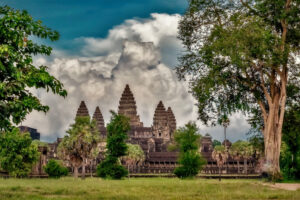 Home to the magnificent temples of Angkor Wat, Siem Reap is a must-visit destination for history enthusiasts and adventure seekers alike. Beyond its iconic archaeological sites, Siem Reap boasts a thriving arts scene, delectable cuisine, and warm hospitality that leaves a lasting impression on visitors.
Home to the magnificent temples of Angkor Wat, Siem Reap is a must-visit destination for history enthusiasts and adventure seekers alike. Beyond its iconic archaeological sites, Siem Reap boasts a thriving arts scene, delectable cuisine, and warm hospitality that leaves a lasting impression on visitors.
Geography and Climate
Siem Reap is located in northwestern Cambodia, near the shores of the Tonle Sap Lake, the largest freshwater lake in Southeast Asia. The city experiences a tropical climate with two main seasons: a wet season from May to October, characterized by heavy rains and high humidity, and a dry season from November to April, which is more temperate and considered the best time to visit. The dry season also coincides with the peak tourist season, especially from December to February, when the weather is most favorable for exploring the temples.
Cultural Highlights and Attractions
- Angkor Archaeological Park: The heart of Siem Reap’s tourist draw, this UNESCO World Heritage Site spans over 400 square kilometers and contains the magnificent remains of the Khmer civilization, including the iconic Angkor Wat, the largest religious monument in the world, Bayon Temple with its serene stone faces, and Ta Prohm, known for the trees growing out of the ruins.
- Angkor National Museum: Offers a deeper understanding of the area’s history and culture through its collections of artifacts and interactive exhibits.
- Cambodian Cultural Village: A theme park and museum offering a glimpse into Cambodian culture and history through miniature villages, dance performances, and museums.
- Artisans Angkor: A social enterprise supporting Cambodian arts and crafts, offering tours to see artisans at work and the chance to purchase high-quality handicrafts.
Activities
- Temple Tours: Exploring the Angkor temples is a must-do activity. Sunrise at Angkor Wat is particularly popular for its breathtaking views.
- Floating Villages: Visit the floating villages of Tonle Sap Lake, such as Kampong Phluk or Kampong Khleang, to see a different way of life.
- Night Markets and Pub Street: The night markets offer a variety of local handicrafts, souvenirs, and street food. Pub Street is famous for its vibrant nightlife.
- Culinary Tours: Cambodian cuisine is a delightful aspect of the culture to explore. Consider a guided food tour or a cooking class to learn about and taste local dishes.
Cuisine
Cambodian cuisine, or Khmer cuisine, features a range of delicious dishes with rice and fish as staples, influenced by Thai, Vietnamese, Chinese, and French cuisines. Must-try local dishes include Amok (a creamy curry cooked in banana leaves), Lok lak (stir-fried beef), and Khmer noodle soups. Siem Reap offers an array of dining options from street food stalls to upscale restaurants.
Accommodation
Siem Reap caters to all types of travelers, offering a wide range of accommodation options from budget hostels and boutique hotels to luxury resorts. Many accommodations are centrally located, providing easy access to the Angkor complex and the city’s dining and entertainment areas.
Travel Tips
- Getting Around: Tuk-tuks are a convenient and affordable way to explore the city and the Angkor complex. Renting a bicycle is another popular option for getting around.
- Visa Requirements: Most visitors need a visa to enter Cambodia, which can be obtained upon arrival at Siem Reap International Airport or in advance through an e-visa online.
- Respect the Culture: When visiting temples, dress modestly by covering shoulders and knees. Always ask for permission before taking photos of people, especially monks.
- Stay Hydrated: The climate can be hot and humid, especially during the dry season, so it’s important to drink plenty of water as you explore.
Siem Reap is more than just the gateway to Angkor; it’s a vibrant city rich in history, culture, and natural beauty, offering a deeply rewarding experience for travelers seeking to explore the wonders of Cambodia.
Hanoi, Vietnam:
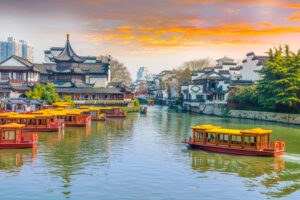 With its bustling markets, colonial architecture, and vibrant street food culture, Hanoi is a feast for the senses. From sipping steaming bowls of pho in the Old Quarter to exploring ancient pagodas and lakeside temples, travelers are drawn to Hanoi’s intoxicating blend of tradition and modernity.
With its bustling markets, colonial architecture, and vibrant street food culture, Hanoi is a feast for the senses. From sipping steaming bowls of pho in the Old Quarter to exploring ancient pagodas and lakeside temples, travelers are drawn to Hanoi’s intoxicating blend of tradition and modernity.
Geography and Climate
Hanoi is located in the northern region of Vietnam, sitting on the right bank of the Red River. It is approximately 90 kilometers (56 miles) inland from the coast. Hanoi experiences a humid subtropical climate with a wet season (May to September) characterized by heavy rains and a dry season (October to April) featuring cooler and drier conditions. The best times to visit are during the transitional months of October-November and March-April when the weather is pleasant with less humidity and milder temperatures.
Historical and Cultural Highlights
- Old Quarter: The heart of Hanoi’s historic charm, the Old Quarter is a bustling area of narrow streets and alleys, known for its French colonial architecture, vibrant markets, street food vendors, and an array of shops selling everything from local crafts to silk products.
- Hoan Kiem Lake: A central feature of Hanoi, known for its peaceful atmosphere and the Turtle Tower sitting on a small island in the center of the lake. Nearby is the iconic red-painted Huc Bridge leading to Ngoc Son Temple.
- Ho Chi Minh Mausoleum Complex: This site includes the final resting place of Ho Chi Minh, the Presidential Palace, and the One Pillar Pagoda. It’s a must-visit for those interested in Vietnam’s modern history.
- Temple of Literature: Founded in 1070, it is dedicated to Confucius and served as Vietnam’s first national university. It’s a prime example of traditional Vietnamese architecture.
Activities
- Explore the Street Food Scene: Hanoi is famous for its street food. Don’t miss trying pho (noodle soup), banh mi (Vietnamese sandwich), and egg coffee.
- Watch a Water Puppet Show: This traditional performance art is unique to Northern Vietnam, showcasing scenes from rural life and national history.
- Visit Museums: The Vietnam Museum of Ethnology and the Hanoi War Museum offer insights into Vietnam’s diverse cultures and turbulent history, respectively.
- Cycling Tours: Join a cycling tour to explore the city or the countryside, including the Red River Delta.
Cuisine
Vietnamese cuisine is known for its balance of flavors and use of fresh ingredients. Hanoi is the birthplace of many iconic dishes, such as pho and bun cha (grilled pork with vermicelli). The city’s food scene ranges from street stalls and local eateries to high-end restaurants, offering a wide variety of tastes and experiences.
Accommodation
Hanoi offers a wide range of accommodations to suit all preferences and budgets, from hostels and guesthouses in the Old Quarter to luxury hotels and boutique accommodations. Many travelers opt to stay in the Old Quarter to be close to the major attractions and experience the city’s vibrant atmosphere.
Travel Tips
- Getting Around: Walking is a great way to explore the Old Quarter and surrounding areas. For longer distances, taxis, ride-hailing apps like Grab, and cyclos (traditional three-wheel bicycles) are convenient options.
- Respect Local Customs: Dress modestly when visiting temples and pagodas. Be mindful of local etiquette, such as removing shoes before entering someone’s home or a place of worship.
- Currency: The Vietnamese Dong (VND) is the local currency. While credit cards are accepted in many hotels and restaurants, cash is king in local markets and street food stalls.
- Safety: Hanoi is generally safe for travelers, but it’s wise to be cautious of your belongings in crowded places to avoid pickpocketing.
Hanoi’s rich history, diverse culture, and vibrant street life offer a compelling urban tapestry for travelers. Whether you’re drawn to explore its historical sites, indulge in its culinary delights, or simply wander through its bustling streets, Hanoi provides a deeply enriching experience that captivates all who visit.
Phuket, Thailand:
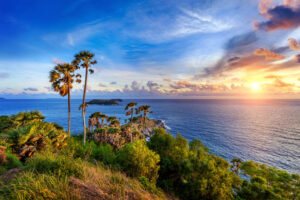 Famed for its pristine beaches, turquoise waters, and vibrant nightlife, Phuket continues to be a top destination for sun-seekers and thrill-seekers alike. Whether lounging on the sand, snorkeling in crystal-clear bays, or exploring nearby islands, visitors revel in Phuket’s tropical paradise and laid-back atmosphere.
Famed for its pristine beaches, turquoise waters, and vibrant nightlife, Phuket continues to be a top destination for sun-seekers and thrill-seekers alike. Whether lounging on the sand, snorkeling in crystal-clear bays, or exploring nearby islands, visitors revel in Phuket’s tropical paradise and laid-back atmosphere.
Geography and Climate
Phuket is located off the west coast of Thailand in the Andaman Sea, connected to the mainland by two bridges. The island features a mountainous landscape with some of the country’s most popular beaches along its western coast. Phuket experiences a tropical monsoon climate, with a rainy season from May to October and a dry season from November to April. The best time to visit is during the dry season when the weather is sunny and suitable for beach activities and exploration.
Attractions and Activities
- Beaches: Patong Beach is the most famous for its nightlife and water sports, while Kata, Karon, and Surin Beaches offer a more relaxed atmosphere perfect for families and couples. Nai Harn and Mai Khao beaches are less crowded, ideal for those seeking tranquility.
- Phi Phi Islands: A day trip to the stunning Phi Phi Islands is a must-do, known for their crystal-clear waters and dramatic limestone cliffs.
- Old Phuket Town: Explore the colorful Sino-Portuguese buildings, boutique shops, and local eateries in Old Phuket Town, offering a glimpse into the island’s rich cultural heritage.
- Big Buddha: This massive 45-meter tall statue sits atop Nakkerd Hill, offering panoramic views of the island.
- Phang Nga Bay: Famous for its limestone karsts jutting out of the emerald-green water, Phang Nga Bay can be explored by boat tours, including a visit to James Bond Island.
- Similan Islands: Renowned for their diving and snorkeling sites, the Similan Islands are accessible by boat tours.
Cuisine
Phuket’s culinary scene is a vibrant mix of Thai and international cuisines, with a strong emphasis on seafood due to its coastal location. Local specialties include Mee Hokkien (stir-fried noodles), Tom Yum Goong (spicy shrimp soup), and Massaman Curry. Don’t miss the opportunity to savor fresh seafood at beachside restaurants or explore the local markets for street food.
Accommodation
Phuket caters to a wide range of preferences and budgets, from luxury resorts and private villas with stunning sea views to affordable guesthouses and hostels. Popular areas to stay include Patong for those looking for nightlife, Kata and Karon for families, and Kamala or Bang Tao for a more secluded experience.
Travel Tips
- Getting Around: Renting a scooter is a popular and convenient way to explore the island, although taxis and Grab (ride-hailing app) are also available for longer distances.
- Respect Local Customs: Thai culture is steeped in respect and politeness. Dress modestly when visiting temples, and always remove your shoes before entering someone’s home or a temple.
- Safety: While Phuket is generally safe, exercise caution with personal belongings in crowded places and be mindful of strong currents when swimming at the beaches.
- Environmental Awareness: Phuket faces challenges with overtourism and environmental degradation. Travelers are encouraged to respect local environmental guidelines and participate in sustainable tourism practices.
Phuket is more than just a beach destination; it offers a rich tapestry of cultural experiences, natural wonders, and culinary delights, ensuring an unforgettable vacation for travelers seeking relaxation, adventure, or cultural immersion in one of Thailand’s most iconic islands.
Seoul, South Korea:
As a dynamic metropolis blending tradition and innovation, Seoul offers a captivating mix of ancient palaces, futuristic skyscrapers, and bustling markets. From sampling mouth-watering street food to immersing oneself in K-pop culture, travelers are enchanted by Seoul’s vibrant energy and rich cultural heritage.
Kathmandu, Nepal:
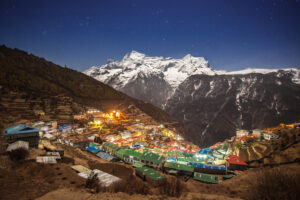 Nestled in the shadow of the Himalayas, Kathmandu beckons adventurers with its ancient temples, bustling bazaars, and breathtaking mountain vistas. Whether embarking on a trek to Everest Base Camp, exploring UNESCO World Heritage sites, or soaking in the spiritual atmosphere, visitors are drawn to Kathmandu’s unique charm and natural beauty.
Nestled in the shadow of the Himalayas, Kathmandu beckons adventurers with its ancient temples, bustling bazaars, and breathtaking mountain vistas. Whether embarking on a trek to Everest Base Camp, exploring UNESCO World Heritage sites, or soaking in the spiritual atmosphere, visitors are drawn to Kathmandu’s unique charm and natural beauty.
Geography and Climate
Kathmandu is situated in the Kathmandu Valley in central Nepal, surrounded by four major mountains: Shivapuri, Phulchowki, Nagarjun, and Chandragiri. The city experiences a temperate climate with four main seasons: a warm spring (March to May), a rainy monsoon season (June to August), a cool autumn (September to November), and a cold winter (December to February). The best times to visit are during spring and autumn when the weather is pleasant, and the skies are clearer, offering stunning views of the Himalayan peaks.
Historical and Cultural Highlights
- Kathmandu Durbar Square: Once the royal palace of the former Kathmandu Kingdom, it is a UNESCO World Heritage Site featuring temples, courtyards, and palaces showcasing Newari architectural excellence.
- Swayambhunath Stupa (Monkey Temple): An ancient religious complex atop a hill in the Kathmandu Valley, west of Kathmandu city. It is one of the oldest and most revered Buddhist shrines in Nepal.
- Pashupatinath Temple: A sacred Hindu temple dedicated to Lord Shiva, located on the banks of the Bagmati River. It is also a UNESCO World Heritage Site.
- Boudhanath Stupa: One of the largest stupas in the world and an important pilgrimage site for Buddhists.
- Patan and Bhaktapur: Nearby cities within the Kathmandu Valley, each with their own Durbar Squares, temples, and unique cultural heritage.
Activities
- Trekking and Hiking: Kathmandu is the gateway to the Himalayas, offering access to numerous trekking routes ranging from day hikes to longer treks like the Everest Base Camp and Annapurna Circuit.
- Cultural Tours: Explore the rich cultural heritage of Kathmandu through guided tours of its ancient sites and temples.
- Shopping: Thamel, the tourist hub of Kathmandu, offers a wide range of shopping opportunities, from traditional Nepalese handicrafts to trekking gear.
- Culinary Exploration: Nepalese cuisine is a blend of Indian, Tibetan, and traditional Nepalese influences. Don’t miss out on momos (dumplings), dal bhat (lentil soup served with rice), and Newari cuisine.
Cuisine
Nepalese cuisine is characterized by its diverse flavors and use of herbs and spices. Staples include lentils, rice, vegetables, and meats, with a notable influence from neighboring countries like India and Tibet. Kathmandu offers a wide range of dining options, from traditional Nepali thalis to international cuisines.
Accommodation
Kathmandu provides a variety of accommodation options to suit all budgets, from luxury hotels and boutique guesthouses to budget lodges and hostels. Many travelers prefer to stay in Thamel for its convenient location, close to shops, restaurants, and cultural sites.
Travel Tips
- Transport: Local buses, taxis, and ride-sharing services like Tootle and Pathao are common ways to get around the city. Negotiate taxi fares in advance.
- Health and Safety: Be cautious of air pollution and drink bottled or purified water to avoid health issues.
- Cultural Sensitivity: Dress modestly, especially when visiting religious sites. It’s customary to remove shoes before entering temples and some homes.
- Permits for Trekking: If you plan on trekking, ensure you have the necessary permits, which can be obtained in Kathmandu.
Kathmandu is not just a starting point for treks into the Himalayas but a destination rich in history, spirituality, and culture. Whether you’re exploring its ancient sites, wandering through bustling marketplaces, or embarking on a journey into the mountains, Kathmandu offers an unforgettable experience for every traveler.
Conclusion:
As travelers eagerly plan their next adventures, the allure of Asia’s diverse landscapes, rich cultures, and vibrant cities continues to captivate the imagination. From the pristine beaches of Bali to the ancient temples of Angkor Wat, each destination on this list offers a unique blend of history, adventure, and relaxation that promises to create unforgettable memories for years to come. So, pack your bags, embark on a journey of discovery, and experience the magic of Asia’s top trending travel destinations in 2024.

